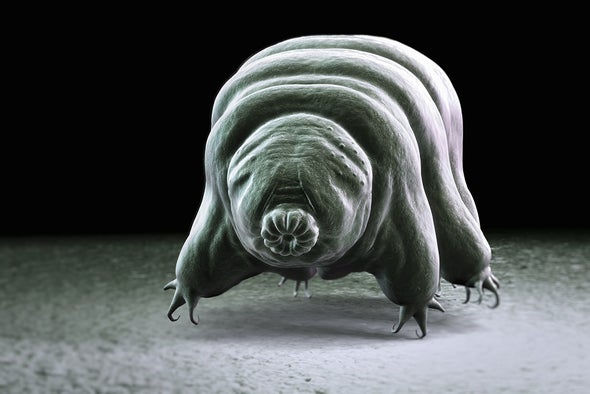(单词翻译:单击)
听力文本
This is Scientific American's 60-second Science, I'm Susanne Bard.
Tardigrades are some of nature's toughest animals. Also known as water bears, the tiny creatures can withstand extreme conditions, like boiling hot temperatures, long periods of dehydration and even oxygen deprivation.
"One of the really cool things about tardigrades is that you can shoot them into outer space, and they can survive the vacuum and radiation of the low-Earth orbit."
University of California, San Diego, biochemist Jim Kadonaga. Of course, he says tardigrades didn't evolve to endure the perils of space travel.
"Many tardigrades live in environments that are both wet and dry, like moss. And when it's wet, they're active. And when it's dry, they can go into a desiccated state that's something like a state of suspended animation."
Normally, dehydration would make tardigrade DNA susceptible to damage from chemicals called hydroxyl radicals, which form when water molecules split. They also form when DNA is exposed to radiation. But Kadonaga suspected that a protein found only in tardigrades, called Dsup, might protect their DNA under both conditions. (Dsup stands for "damage suppressor protein.")

"And the remarkable thing about this Dsup protein is that when you put it into human cells in the laboratory, it makes those cells more resistant to x-ray radiation."
Kadonaga's team, led by then undergraduate student Carolina Chavez, studied how Dsup protects DNA in cells. They found that it binds to chromatin, the compact structure that allows long molecules of DNA to ball up and fit into a tiny cell. The researchers think Dsup acts as a sort of chromatin insulator, shielding DNA from attack by hydroxyl radicals. They conclude that the protein is likely the key to the tardigrade's extreme hardiness in conditions that would prove lethal to most other organisms.
The study appears in the journal eLife.
Kadonaga says understanding the tardigrade's secret weapon may also inform biotechnology and pharmaceutical research.
"And so, now that we know how Dsup works, we might be able to use that knowledge to make designer versions of Dsup that can be used to potentially make cells more durable or longer-lived."
Thanks for listening for Scientific American's 60-second Science. I'm Susanne Bard.
参考译文
这里是科学美国人——60秒科学系列,我是苏珊娜·巴德。
缓步动物是自然界中最顽强的动物之一。这种小动物也被称为水熊,它们可以忍受极端条件,比如滚烫的温度、长时间脱水甚至缺氧。
“缓步动物非常酷的一点是,你可以把它们发射到外太空,它们可以在低地球轨道的真空和辐射中存活下来。”
加州大学圣地亚哥分校的生物化学家吉姆·卡多纳加说到。当然,他说,缓步动物的进化并不是为了承受太空旅行的危险。
“许多缓步动物生活在潮湿和干燥的环境中,比如苔藓。当天气潮湿时,它们就会活跃起来。当天气干燥时,它们会进入一种干燥的状态,就像一种假死状态。”
通常情况下,脱水会使缓步DNA容易受到一种名为羟自由基的化学物质的伤害,这种物质在水分子分裂时形成。当DNA暴露在辐射中时,也会形成这种物质。但卡多纳加怀疑,在这两种情况下,只在缓步动物身上发现的一种名为Dsup的蛋白质可能会保护它们的DNA。(Dsup是“损伤抑制蛋白”的缩写)。
“这种Dsup蛋白的特别之处在于,如果将其放入实验室的人类细胞中,它会使这些细胞更能抵抗X射线辐射。”
卡多纳加的团队,由当时的本科生卡罗莱纳·查韦斯领导,研究了Dsup如何保护细胞中的DNA。他们发现,它能与染色质相结合,染色质是一种紧密的结构,这种结构能使DNA的长分子聚集起来,并适合一个微小细胞。研究人员认为,Dsup作为一种染色质绝缘体,可以保护DNA免受羟基自由基的攻击。他们得出的结论是,这种蛋白质很可能是这种缓步动物在对大多数生物都是致命的条件下保持极端耐受性的关键。
这项研究发生在《eLife》期刊上。
卡多纳加表示,了解缓步动物的秘密也可能为生物技术和制药研究提供信息。
“所以,现在我们知道了Dsup的工作原理,我们也许能够利用这些知识制造出设计版本的Dsup,这种Dsup可以潜在地使细胞更耐用或更长寿。”
谢谢大家收听科学美国人——60秒科学。我是苏珊娜·巴德。
译文为可可英语翻译,未经授权请勿转载!
重点讲解
重点讲解:
1. be susceptible to 易受(伤)的;
Some of these plants are more susceptible to frost damage than others.
这些植物中有一些较其他的易受霜冻危害。
2. be exposed to 使暴露于(险境);使遭受(危险或不快);
They were exposed to radioactive fallout during nuclear weapons tests.
在核武器试验中他们暴露在放射性尘埃之下。
3. be resistant to 有抵抗力的;不受…损害的;
Cotton is more resistant to being squashed and polyester is more resilient.
棉布更抗压,而涤纶更有弹性。
4. ball up (使)成球状(或团块);
She balled the handkerchief up and threw it at his feet.
她把手绢揉成一团,丢在了他的脚边。


